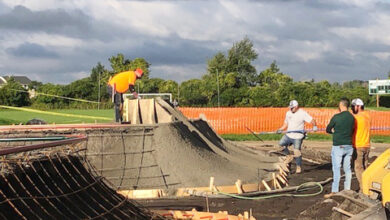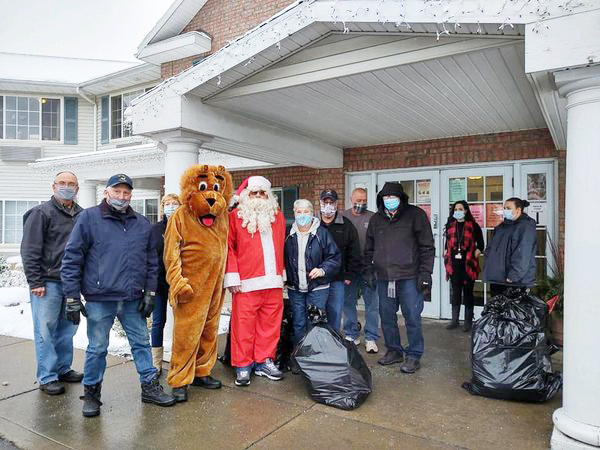Violin restorations make sweet music
Hilton luthier blends musical and wood crafting talents in avocation
by Kristina Gabalski
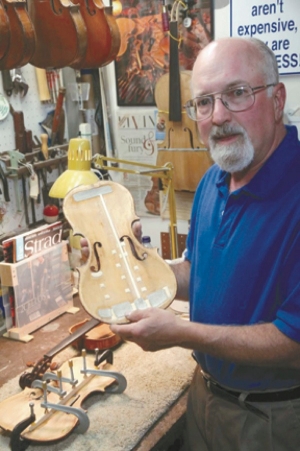 Parma resident Doug Wall retired from Kodak in 2005, after working there for 34 years as a chemist. He became interested in violin repair about a year later and used his retraining allowance from Kodak to attend a school in North Adams, Massachusetts. He goes back every year for a week of specialized training. Above, he displays the inside of the top of a violin where he has bridged some cracks with glued cleats. It’s not very often that a vacation leads to a new avocation, but that was the case for Doug Wall, who skillfully restores old violins in a workshop in his home just north of the village of Hilton.
Parma resident Doug Wall retired from Kodak in 2005, after working there for 34 years as a chemist. He became interested in violin repair about a year later and used his retraining allowance from Kodak to attend a school in North Adams, Massachusetts. He goes back every year for a week of specialized training. Above, he displays the inside of the top of a violin where he has bridged some cracks with glued cleats. It’s not very often that a vacation leads to a new avocation, but that was the case for Doug Wall, who skillfully restores old violins in a workshop in his home just north of the village of Hilton.
Doug was on a trip to Scotland in 2002, when he heard “wonderful fiddling music.” Intrigued, he decided to learn how to play.
“I was around 50 years old and said, ‘I gotta try that,’ ” Doug says. “I had no musical background at all.”
A year after the trip, he found a teacher, purchased a fiddle and started lessons.
“In 2005, I escaped from Kodak voluntarily,” Doug says. His fiddle teacher, knowing his talents and interest in woodworking, told him about violin repair and restoration workshops where he could learn the craft.
Doug says he attended his first workshop in 2006, led by Hans Nebel at the Massachusetts College of Liberal Arts.
“I fell in love with working on the instruments and am continuing to take classes every year,” he says.
Nebel is a renowned violin repair expert, Doug says. He is a third-generation member of a violin-making family in Germany. He came to the U.S. in the 1950s and is now 73 years old.
“He’s a phenomenal restorer – there’s no way to match what he does, he’s a great inspiration,” Doug says. “He’s one of the few people that people will take a Stradivarius to to get repaired.”
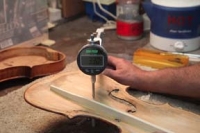 Doug uses an electronic thickness gauge to make sure his work is correct. Doug estimates he has amassed about 400 hours of training over the past several years and says the technical name for his craft is luthier – someone who repairs string instruments. The work he does has changed little over the centuries.
Doug uses an electronic thickness gauge to make sure his work is correct. Doug estimates he has amassed about 400 hours of training over the past several years and says the technical name for his craft is luthier – someone who repairs string instruments. The work he does has changed little over the centuries.
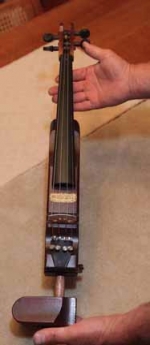 A Fiddle-ette is a vintage redwood violin. It can be played as a full violin or a three-quarter violin. Only a few thousand were ever made. “I like working with old instruments; it can be challenging to restore them correctly,” he says. He does crack repairs, neck resetting, scroll grafting, rib repairs, varnish retouching and patching and re-arching. Wall says his wife, Cathy, “Supports my work 100 percent; that’s important.” About twenty percent of his work is repairs; the other eighty percent is refurbishing and restoring. “If Stradivari walked into my workshop, the tools would seem familiar to him,” Doug explains. Stradivari died in 1737.
A Fiddle-ette is a vintage redwood violin. It can be played as a full violin or a three-quarter violin. Only a few thousand were ever made. “I like working with old instruments; it can be challenging to restore them correctly,” he says. He does crack repairs, neck resetting, scroll grafting, rib repairs, varnish retouching and patching and re-arching. Wall says his wife, Cathy, “Supports my work 100 percent; that’s important.” About twenty percent of his work is repairs; the other eighty percent is refurbishing and restoring. “If Stradivari walked into my workshop, the tools would seem familiar to him,” Doug explains. Stradivari died in 1737.
Doug enjoys working with people and most often works to bring “attic violins” – instruments long neglected in attics or closets – back to life.
“People will come in with a violin that belonged to their grandfather and want to get it back into playing condition,” he says.
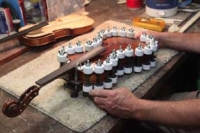 Spool clamps hold the top (the belly) and sides together while the hide glue dries, (overnight).Doug can also help violinists and students who need their instruments repaired and he sells violins, bows and strings.
Spool clamps hold the top (the belly) and sides together while the hide glue dries, (overnight).Doug can also help violinists and students who need their instruments repaired and he sells violins, bows and strings.
When a customer brings a violin in, Doug first evaluates the instrument in a multi-step process to ascertain its age and how and where it was made.
“I enjoy working with clients and explaining things to them,” he says.
Once the evaluation is complete, he will discuss options for repair and restoration.
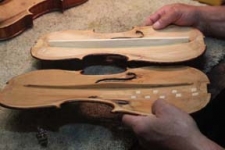 This view of two violin interiors shows the difference between a bass bar that has been initially installed and what it looks like after it has been trimmed. Shaping it properly improves the sound.“Most of the time, I can help out,” he says and will refer a client to someone else if he feels the work that needs to be done requires more skill than he has attained.
This view of two violin interiors shows the difference between a bass bar that has been initially installed and what it looks like after it has been trimmed. Shaping it properly improves the sound.“Most of the time, I can help out,” he says and will refer a client to someone else if he feels the work that needs to be done requires more skill than he has attained.
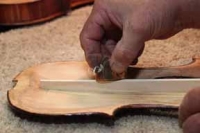 A finger plane is used to remove bits of the bass bar. There are 74 individual pieces in a violin. The archeology of the instruments fascinates Doug – the process of determining the age, origin and assessing previous repairs.
A finger plane is used to remove bits of the bass bar. There are 74 individual pieces in a violin. The archeology of the instruments fascinates Doug – the process of determining the age, origin and assessing previous repairs.
“What intrigues me about working on the violins is the puzzle you run into,” he says, “and deciding how to repair them.”
Much of the restoration work must be done by hand, including fitting all the parts to the violin, Doug says.
Many materials are also used in the re-touching process. Doug uses resins to mix colors to match the color of the instrument’s varnish. Powdered soluble pigments are used to meticulously restore even the finest grains.
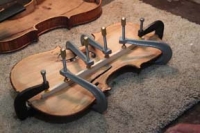 Clamps hold down the glued bass bar, the major piece running up the middle of the inside of a violin. Doug uses chalk to determine the proper fit of the spruce bass bar to the back of the violin. High points show up with chalk and need to be trimmed back. He uses hide glue to affix the bass bar. The bass bar is the beam that allows a violin to withstand the pressure of the strings. It’s very rewarding to take an old violin and bring it back to playing condition,” he says. “It’s very, very interesting work, fascinating work. I love to do it.”
Clamps hold down the glued bass bar, the major piece running up the middle of the inside of a violin. Doug uses chalk to determine the proper fit of the spruce bass bar to the back of the violin. High points show up with chalk and need to be trimmed back. He uses hide glue to affix the bass bar. The bass bar is the beam that allows a violin to withstand the pressure of the strings. It’s very rewarding to take an old violin and bring it back to playing condition,” he says. “It’s very, very interesting work, fascinating work. I love to do it.”
Note: Other information is available on Wall’s website: www.wallindependent.com.




